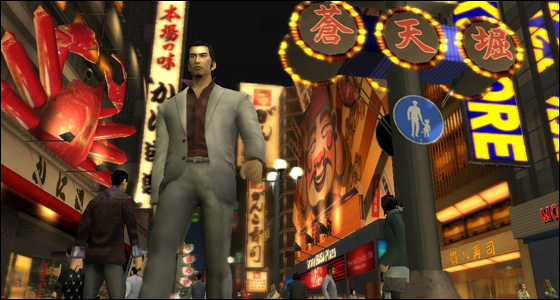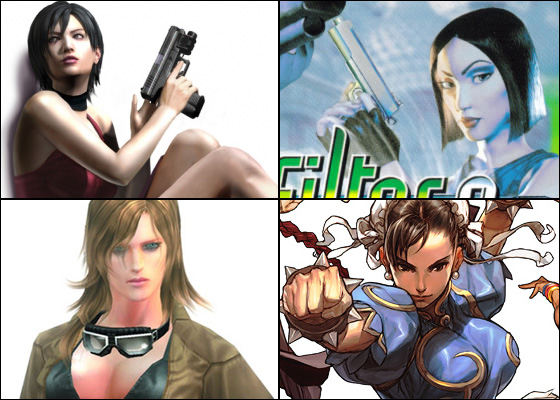Yakuza 2: The Cultural Dynamite
February 20th, 2009

Yakuza 2 (Playstation 2) is a game that I probably would have overlooked if it wasn’t for the recommendations by several bloggers, billing this title as one of last year’s most overlooked gems. The recommendations alone piqued my interest, but the more I read into Yakuza 2 the more it revealed itself as the sort of game I’ve been looking to play.
For one, the game was caught in the trap of being a late release stuck on a console slowly on the software decline, the sort of game I can sympathize with. Secondly, Yakuza 2 appeared to adopt much of the detailed-world-and-exploration elements of Shenmue (Dreamcast); a game that I’ve always wanted to but never had the chance of playing. The most intriguing element though would undoubtedly be the cultural exuberance. As a student of cultural things I’ve always been keen to understand and discuss the ways in which culture is adapted to video games*. Yakuza 2 appeared to be a game which did this quite well. Appearances in this case are very telling as Yakuza 2 is cultural dynamite.
Yakuza 2 flaunts its culture on both macro and micro levels. The macro level implementation isn’t really worth talking about because it’s already very obvious from the outset – the game and all of it’s contents are made and set in Japan. But to just quickly form a small list of those, I’d include:
Japanese spoken dialogue during cutscenes
Japanese approach to detective/crime story telling
the setting; inner city Japan
Yakuza subject matter
authentic rendering of two respective cities including architecture, signage and products
Micro Level Implementations
I find the micro level stuff to be much more interesting as culture is most effective in it’s subtle undertones; the one’s that aren’t very often made aware to the reciever. In that respect, the mass combination of cultural subtleties are fundamentally Yakuza 2’s key strength.
Take the scene setting for example. In the frequent downtime between narrative based affairs you’ll spend a good deal of your time soaking up city life. The city environment likens itself to a real city by the way it connects the player to the street-side NPCs. Just by walking down the street, speech bubbles of text appear depicting the words of pedestrians populating the sidewalk. You can’t actually respond to the good majority of these people – and just like in real life, you probably wouldn’t intrude on the conversations of passers by – but their words create an air of atmosphere, rather than being rudimentary set pieces standing in for the sake of it. The sounds of city chatter and pictures of people grouped together in conversation complement the city vibe created by the text bubbles. Through these subtle techniques, life is injected into the city without way of graphic or sound.
The cultural relevancies of Japan are woven throughout those speech bubbles with people complaining about the differences between Osakan and Tokyo people or how the environment has changed from the way it use to be. These pieces of chatter (sometimes they are relayed through text bubbles or through player interaction) all act as a means to share cultural small talk with the player.

Within the Japanese cities are interior areas such as restaurants and bars accessible from the city hub. The internal areas are more or less avenues for spending money from your healthy yakuza bank account in turn being rewarded by your mild consumerism with experience points. The products and services in this case relate back to the culture, but again Yakuza 2 strives in the details. When it comes to food and beverages, waiters and bar tenders are keen to talk in detail about the item, how it was made and what ingredients were used to make it. These brief info-bites are chocked full of information and are delivered to you when either selecting or after purchasing a beverage/meal.
Services on the other hand come in the form of escorts, a movie renting service (in which you sit in a room provided to you and watch) and a sort of escort-like luxury service. The latter in which you go to a bar, drink and eat with a lady of your choice for a few hours. The fact that I don’t even know what to call this service (since we don’t have them in Australia!) perhaps speaks lengths as to the cultural strength of the title and how it remained unmodified for the western release. Most of these services differ from their western counterparts, some Japanese only. The fact that the game allows you to play around in such instiutions, opens up huge opportunities for cultural understanding.
Yakuza 2 graphically has a very murky, darkened look to it. It looks a little fuzzy and unclear as well. Unfortunately it does damage the experience a little, but it’s also something that I think harkens back to the cultural elements of the title. Densely populated Asian cities like Shanghai, Hong Kong and Tokyo are all infamous for being surfaced with a layer of dirt and dust caused by the dense population and heightened industrialism. It’s hard to know whether the game is just a little dark or if it’s a reflection of one of the more menacing aspects of Asian cityscapes.
To finish off on my tour of subtle cultural quirks I want to talk about the game’s combat, specifically the animations and sound effects behind each punch, hurl and kick. Each attack available to Kiryu animates fiercely and with swift velocity. The rushed flow of animation combined with some cringe-worthy specials evoke a sense of style similar to the rough and tough fighting scenes from the GTO Early Years manga series and undoubtedly many other examples of Asian brawling media (Hong Kong action cinema etc.).
That wraps up my observations on Yakuza 2’s cultural quirks. I’ve still only scratched the surface of the game, so this post may be followed up with more of the same as I continue to play.
* Unfortunately there aren’t many culturally interesting games, nor am I much of a champion of the cultural games niche.
The Convenience of Chinese Ethnicity in Games?
November 22nd, 2008
I remember a few years ago I was watching an interview with Jackie Chan, and one of his comments struck a chord with me. He mentioned that in movies, particularly western movies, the Asian guy never kisses the girl. That’s quite interesting isn’t it? Interesting because he is dead-on in that cultural archetypes and shape media. No one really wants an Asian guy to pash the lovely American actress now do they? Well at least not in western films.
That’s one good example of how culture affects media in the most subtle of ways, beyond the posh British waiter and clichéd American hero. Here is another, much similar to the last. What do all of these female video game characters have in common?

Ada Wong (Resident Evil), Lian Xing (Syphon Filter), EVA (Metal Gear Solid) and Chun-Li (Street Fighter)
That’s right they are all Chinese, well the good bits.
Obviously many attributes have been toned down, while others have been toned up to fit the appropriate audiences. I mean, skin is nice and white, the orientation of the eyes are relaxed, bust is increased and clothes are not particularly Chinese in style (even by contemporary Chinese fashion). These women (excluding Chun-Li) all seem like American born Chinese instead of native Chinese.
A question to you readers, do you think that these characters quantify as culturally authentic and not characters retooled for the western audience? Judging by their appearance, accent, behaviour and so forth. Furthermore, is this perhaps a responsible thing to do and what are the implications of it?
I will share my ideas in another post..well still deciding to respond or to leave it as food for thought. (Yes, that’s right dolling them out in desperation).
Observations from the Shanghai Subway
November 10th, 2008

After being here for maybe two months I’ve realized that I haven’t actually said much about the gaming scene in China. I’ve been to a few arcades, shuffled through pirated and import markets, observed gaming on the subway and made friends who all play games in some form or another. I also have a room mate who owns a Japanese Sega Saturn, although, he is creepy, so I probably won’t explore that avenue!
The only facet that I feel well grounded in is gaming on the Shanghai subway, which is much more prominent than you might first assume. Inspired by Stephen Totilo, I decided to keep a tab of the number of times I spotted a handheld game being played on my daily commute and back. Unfortunately, the more I tally, the more I realize how useless my original plan is since the PSP is wiping the floor clear.
While Mr Totilo counted something near 70 PSPs on the New York subways in over a year, in only two months I have see upwards of 30 PSPs being played. I see at least one PSP player a day, sometimes up to five or six. The DS on the other hand is much lower but I occasionally spot a DS, which my tally being up to around eight. It’s quite obvious which way the data will skew, so I have decided to give up counting.
A lot of rich Shanghai’ers are also equipped with flashy mobile phones too and much like anywhere it is common to see people flash them out in public. The most popular mobile phone games are simple card games, Mahjong and Bubble Bobble.
For the DS I’ve spotted one of the Harvest Moon games being played (the 3D, isometric one) as well as some Castlevania. I’m not sure if people are using a SD card adapter but it is likely as they are readily available.
For the PSP I have seen it been used for a number of features. Games have included God of War, GTA: LCS, Jean D’arc and a number of popular Asian titles; weird stuff like half turn based, half board game RPGs. The PSP is also used quite often as a movie and MP3 player, I see more of this in public than games being played. Most surprising of all is that the most widely used function of the PSP (and by a considerable margin) is to display .txt files. Ridiculous I know, but is quite common to see passengers scrolling through a novel of Chinese characters while jammed between the divides.
And that concludes all that I have to report. I want to do some general surveys on gaming in China soon, wrap up my thoughts on internet cafe culture and start doing some actual analysis of networked games that my friends are hooked on as well as the pirating/import scene. I’m currently doing some general online and forum research.



 Game Design Companion: A Critical Analysis of Wario Land 4 - $7.99
Game Design Companion: A Critical Analysis of Wario Land 4 - $7.99 Level Design: Processes and Experiences
Level Design: Processes and Experiences Speed Boost: The Hidden Secrets Behind Arcade Racing Design - $5.99
Speed Boost: The Hidden Secrets Behind Arcade Racing Design - $5.99 Adventures in Games Analysis: Volume I - $5.99
Adventures in Games Analysis: Volume I - $5.99







